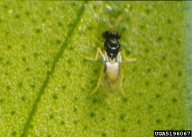
Natural enemy composition rather than richness determines pest suppression
Sign Up to like & getrecommendations! Published in 2018 at "BioControl"
DOI: 10.1007/s10526-018-9870-z
Abstract: Natural enemy (NE) biodiversity is thought to play an important role in agricultural pest suppression. However, the relative importance of the number of NE species (species richness), versus the particular combinations of species (species composition),… read more here.
Keywords: suppression; natural enemy; composition; pest suppression ... See more keywords

Digital video surveillance of natural enemy activity on Diaphorina citri (Hemiptera: Liviidae) colonies infesting citrus in the southern California urban landscape
Sign Up to like & getrecommendations! Published in 2017 at "Biological Control"
DOI: 10.1016/j.biocontrol.2017.10.004
Abstract: Abstract The Asian citrus psyllid, Diaphorina citri, is a significant economic pest of citrus because it vectors a bacterium that causes the lethal citrus disease huanglongbing. From 2015 to 2016, digital video recorders were used… read more here.
Keywords: citri colonies; natural enemy; citri; citrus ... See more keywords

Relationships between natural enemy diversity and biological control.
Sign Up to like & getrecommendations! Published in 2017 at "Current opinion in insect science"
DOI: 10.1016/j.cois.2017.01.001
Abstract: Natural enemy diversity generally strengthens biological control, but individual studies have found everything from positive to negative effects. We discuss the factors that promote these different outcomes. We argue that a trait-based approach is helpful… read more here.
Keywords: enemy diversity; enemy; biological control; natural enemy ... See more keywords

Adding a Natural Enemy to Respond to Pest Immigration and Delayed Natural Enemy Releases in Augmentative Biological Control
Sign Up to like & getrecommendations! Published in 2021 at "Environmental Entomology"
DOI: 10.1093/ee/nvab007
Abstract: Abstract Whether increased natural enemy density or adding a second natural enemy species will provide superior pest suppression in greenhouse augmentative biological control is unknown for many commercially available natural enemy species. In this study,… read more here.
Keywords: enemy; suppression; immigration; natural enemy ... See more keywords

Landscape Complexity has Mixed Effects on an Invasive Aphid and Its Natural Enemies in Sorghum Agroecosystems
Sign Up to like & getrecommendations! Published in 2022 at "Environmental Entomology"
DOI: 10.1093/ee/nvac036
Abstract: Abstract Landscapes with more complex composition and configuration are generally expected to enhance natural enemy densities and pest suppression. To evaluate this hypothesis for an invasive aphid pest of sorghum, Melanaphis sorghi Theobald (Hemiptera: Aphididae),… read more here.
Keywords: landscape complexity; natural enemy; aphid natural; natural enemies ... See more keywords

Dynamic Economic Thresholds for Insecticide Applications Against Agricultural Pests: Importance of Pest and Natural Enemy Migration
Sign Up to like & getrecommendations! Published in 2023 at "Journal of Economic Entomology"
DOI: 10.1093/jee/toad019
Abstract: Abstract In Integrated Pest Management programs, insecticides are applied to agricultural crops when pest densities exceed a predetermined economic threshold. Under conditions of high natural enemy density, however, the economic threshold can be increased, allowing… read more here.
Keywords: enemy; insecticide applications; pest natural; dynamic thresholds ... See more keywords

Differential induction of volatiles in rice plants by two stink bug species influence behaviour of conspecifics and their natural enemy Telenomus podisi
Sign Up to like & getrecommendations! Published in 2020 at "Entomologia Experimentalis et Applicata"
DOI: 10.1111/eea.12869
Abstract: Tritrophic interactions mediated by semiochemicals have been intensively studied from the viewpoint of ecological relationships with Nearctic tritrophic organisms. However, there are few studies involving interactions with different herbivores on the same host plant in… read more here.
Keywords: rice; natural enemy; telenomus podisi; rice plants ... See more keywords

STUDY OF A PREDATOR–PREY MODEL WITH PEST MANAGEMENT PERSPECTIVE
Sign Up to like & getrecommendations! Published in 2019 at "Journal of Biological Systems"
DOI: 10.1142/s021833901950013x
Abstract: Recently, pest control has become a very interesting research topic because it is closely associated with agricultural and economic loss. Empirical evidence shows that pest insects are responsible for lower crop production and many other… read more here.
Keywords: enemy; system; natural enemy; model ... See more keywords

‘Tidy’ and ‘messy’ management alters natural enemy communities and pest control in urban agroecosystems
Sign Up to like & getrecommendations! Published in 2022 at "PLoS ONE"
DOI: 10.1371/journal.pone.0274122
Abstract: Agroecosystem management influences ecological interactions that underpin ecosystem services. In human-centered systems, people’s values and preferences influence management decisions. For example, aesthetic preferences for ‘tidy’ agroecosystems may remove vegetation complexity with potential negative impacts on… read more here.
Keywords: tidy messy; management; natural enemy; manipulation ... See more keywords

A Fuzzy-Based Model to Predict the Spatio-Temporal Performance of the Dolichogenidea gelechiidivoris Natural Enemy against Tuta absoluta under Climate Change
Sign Up to like & getrecommendations! Published in 2022 at "Biology"
DOI: 10.3390/biology11091280
Abstract: Simple Summary Tuta absoluta is an invasive pest threatening the productivity of the tomato crop. Dolichogenidea gelechiidivoris was imported and released as a natural enemy of Tuta absoluta. Mapping the efficacy of Dolichogenidea gelechiidivoris can… read more here.
Keywords: tuta absoluta; tuta; dolichogenidea gelechiidivoris; natural enemy ... See more keywords

Perennial Flowering Plants Sustain Natural Enemy Populations in Gobi Desert Oases of Southern Xinjiang, China.
Sign Up to like & getrecommendations! Published in 2022 at "Insects"
DOI: 10.3390/insects13050399
Abstract: Natural habitats play crucial roles in biodiversity conservation and shape the delivery of ecosystem services in farming landscapes. By providing diverse resources to foraging natural enemies, they can equally enhance biological pest control. In this… read more here.
Keywords: oases southern; natural enemy; desert oases; plant ... See more keywords